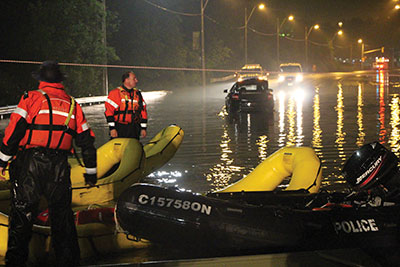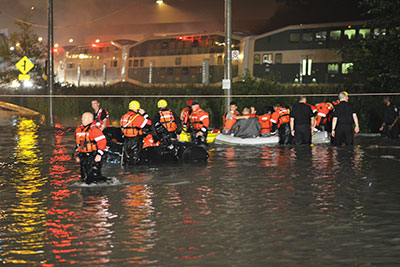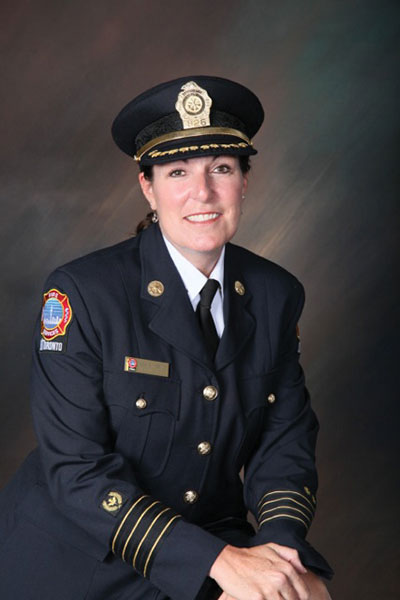
Features
Hot topics
Incident reports
Rush-Hour Rescue
As I started to write this story, I went back to review a very long email stream with another Toronto Fire Services (TFS) deputy chief from the evening of July 8.
September 9, 2013
By Debbie Higgins
As I started to write this story, I went back to review a very long email stream with another Toronto Fire Services (TFS) deputy chief from the evening of July 8. A significant rainstorm had hit the City of Toronto; he was at the city’s Emergency Operations Centre (EOC) and I was at our Communications Centre, trying to get a handle on the calls for service. My review of that email string reminded me how fast events occurred that night, and how quickly they changed from moment to moment.
Let’s go back to the beginning.
 |
|
| Rising waters nearly paralyzed the unsuspecting city around rush hour. The result was 1,185 calls requiring 2,386 vehicle responses, the majority of which occurred in a 10-hour period. photos by desmond brett and larry thorne
|
It was late on Monday afternoon and I was completing my day with an off-site meeting close to TFS headquarters in the south end of the city. As the meeting progressed, I watched the sky get dark and the rain begin to fall in quantities larger than I could ever recall seeing. Within minutes, cars driving by the window were struggling through deep puddles of water that were on the verge of becoming ponds. Shortly thereafter, the power went out. Knowing that our Communications Centre was likely affected (due to proximity), after an outage of more than half an hour, I decided it was time to check in.
The on-call deputy had been trying to reach communications, and when he was unable to, he contacted me and asked me to return as he headed back toward the city. I arrived back at headquarters shortly after 1900 hours to find our telephone lines completely overwhelmed (resulting in the inability to contact the Communications Centre), calls being received over radio channels from Toronto Police, and more than 350 stacked calls waiting for a vehicle to be available to respond. We soon became aware of neighbouring fire departments receiving our 911 calls; those departments were also having trouble reaching our Communications Centre through the dedicated Ontario Office of the Fire Marshal radio channel – which is assigned to all fire departments in the province – as no personnel had yet been assigned to monitor those transmissions. The Communications Centre was operating on back-up generators, meaning that we did not have all of our resources available to us – we lost our ability to connect with local news channels and traffic-management cameras. Staff truly were working in the dark. Because of the issues with the power, support staff from our CAD and radio sections were called back into service to resolve communications issues as they occurred. In addition, the amount of water on the streets caused many issues for responding vehicles, requiring mechanics to also be called back into service to keep our resources operational.
Staffing in our Communications Centre that night included three recruits who had just graduated the preceding Friday, and who were meant to still be working in tandem with veteran staff. That was quickly determined to no longer be feasible, as it was an all-hands-on-deck situation.
The merging of two storm cells over the greater Toronto area resulted in flash flooding of major arterial roads, water courses, buildings, and hydro vaults, with significant power outages. Communications staffing was at minimum levels and the operations division had six trucks out of service due to insufficient staffing.
The staff who worked the 24-hour shift during which the storm occurred responded to 1,185 calls requiring 2,386 vehicle responses, the majority of which occurred in a 10-hour period. During the course of the storm, TFS responded to and dealt with a structural collapse, one third-alarm and two second-alarm fires, and 133 elevator rescues, in conjunction with a GO Transit incident requiring the safe evacuation of more than 1,400 passengers from a commuter train.
In the Communications Centre, in addition to the regular call taker/dispatcher staffing (including two captains and a district chief), we had a division chief (who happened to be at the meeting with me when the call came). The on-call deputy returned to the Communications Centre but was immediately dispatched to the EOC, taking with him the on-call division commander. I remained at the Communications Centre for the duration, calling in an on-duty platoon chief to help deal with specific large-scale incidents – such as the technical water rescue of passengers on the GO train – and recommendations for coverage across the city with so many units out of their stations at the same time.
There were no weather watches or warnings in place prior to the start of the storm. A flood watch was issued by the Toronto Region Conservation Authority at 1721, which was upgraded to a flood warning at 1928. By the time the flood warning was issued, the city’s EOC had already been activated, along with the Toronto Police Major Incident Command Centre (MICC). Both of these centres activate when situations call for an emergency management response structure beyond normal daily operations.
Staffing in the EOC consisted of the following departments/divisions, which worked throughout the night to monitor the situation, respond to and reduce the impact of the emergency, and restore the municipality to a normal state as soon
as possible:
- Office of Emergency Management (including Emergency Human Services)
- Toronto Fire Services
- Strategic Communications
- Toronto Police Service
- Toronto Transit Commission
- Transportation Services
- Emergency Medical Services
- Toronto Water and Geographical Information Systems (GIS).
In the eight hours between 1600 and midnight, TFS responded to 902 incidents (compared to 127 incidents during the same time period in 2012). As would be expected, a large number of the calls were fire alarm checks (352 incidents) and water problems (139 incidents). Crews were busy responding to address after address, checking on residents and ensuring their safety as the excessive rain flooded basements and other areas. We had 18 calls for wires down, and responded to 100 medical incidents, 25 vehicle accidents (including one with a fire), and 156 rescue calls. The most significant of the rescue calls involved five people trapped in a tree who had been trying to escape the fast-moving water beneath them, and the flooded GO train. In addition, we responded to 54 fire calls, including one that escalated to a third alarm, and two that became second-alarm fires. The number of stacked calls continued to climb as several incidents tied up a significant number of resources, resulting in fewer trucks being available for single-truck responses. When significant emergencies like this happen in Toronto, our response protocols change to reflect single-truck responses wherever possible, and include a triage system that ensures responses are sent first to fire and medical emergencies, while calls deemed less emergent are stacked while waiting for resources to become available. This, unfortunately, results in a much higher call volume, as residents who have been waiting for a response call in several times, resulting in a significant number of duplicate and triplicate calls that must be reconciled.
The first of the many significant incidents that occurred in the midst of hundreds of other emergency calls came in at 1817. This was a call for a building collapse. The property was a warehouse facility, and a portion of the roof approximately 30 metres (100 feet) by 15 metres (50 feet) had collapsed under the weight of the water. All staff evacuated safely from the building, but the collapse affected the fire detection and suppression systems in the building as the main sprinkler line was ruptured. Gas was shut off to the building, although Enbridge Gas was required to fix a leak in the shut-off valve. Hydro was shut off to the entire building to ensure there were no incidents when power was restored to the area. Our crews secured the building and the property manager arranged for security to guard the site.
 |
|
| Severe flooding caused a rush-hour commuter train to be stranded. Firefighters and other first responders used marine equipment to rescue some 1,400 passengers – 12 at a time.
|
The initial call for the GO train incident came in at 1931 and indicated that the train was stranded due to flooding, with between 200 and 300 people on board. Rescue 321 was dispatched, arrived on scene and assumed command within 10 minutes. Police were already on scene, and shortly thereafter their marine unit arrived and began to evacuate passengers using inflatable boats, while TFS set up for technical water rescue. There was concern expressed around this time that the train might tip over as it appeared to be leaning; it was feared that the current from the rising water might be disturbing the track bed. Information from GO later revealed that that the train listed because there is a bank built into the tracks on most curves, and this train happened to be stranded on a curve. EMS crews were taken to the train by boat, and remained on the train to deal with passenger concerns. Toronto Transit Commission buses were brought in to provide shelter to passengers once they were safely evacuated from the train. It quickly became apparent that there were more people on board than originally indicated; in the end, up to 1,400 passengers were evacuated. Passengers were removed from the train by boat at a very slow pace – eight to 12 at a time – until midnight when the water started to recede and passengers were able to self evacuate on foot along a parallel track.
At 2046, TFS received a fire call to 1901 Weston Rd., a highrise residential property. This call eventually escalated to a third-alarm fire. The fire was located on the 10th floor, and without power there were no alarms sounding in the building and no elevators operating. This was initially thought to be a hoarding situation as the unit in question had a significant fire load comprising clothing and other debris. The fire extended to the 11th floor apartment above before it was knocked down at 2110. Crews remained on scene for several hours, with the last truck clearing at 0035. Staff from Emergency Human Services were involved in relocating 10 people who were unable to return to their homes.
At 2219, a fire call came in for another high-rise apartment fire. Following our high-rise fire protocol, the call was escalated to a second-alarm response due to heavy smoke in hallway, with a confirmed fire. This fire appeared to be caused by the use of candles during the power outage, which ignited a fire in the bedroom of the unit. The fire was quickly knocked down and the smoke ventilated, with crews clearing within an hour to be available for other responses.
Another second-alarm call came in at 2246 at a detached dwelling – another fire that originated in a bedroom and quickly filled the bungalow with black smoke. This fire was also knocked down quickly, allowing the majority of the crews assigned to be back in service for other emergencies within an hour.
By the end of the night, four vehicles had been removed from service due to engine damage caused by ingesting water in the air intake. Additional damage to vehicles caused by water infiltration has been uncovered since the storm, including control boxes on aerial ladders, water in rear differentials, and damage to electrical components. It was expected that more damage would continue to be discovered in the weeks following the flooding.
When I left the Communications Centre just after 0100 hours on July 9, there were approximately 120 calls still in the queue, all check calls and water problems. The rain had largely stopped, and crews were busy catching up on calls after having resolved the most significant emergencies of the night. It should be noted that many fire halls remained without power for a significant period of time, three until late Wednesday afternoon.
This event caught the City of Toronto off guard, but the emergency protocols kicked into place relatively quickly and city staff and others did a tremendous job mitigating problems.
 |
|
Debbie Higgins is a deputy chief with Toronto Fire Services, responsible for fire prevention and public education. Debbie previously held the portfolio of staff services and communications, following her promotion to deputy in 2010. Prior to this, Debbie spent 11 years as an executive officer for TFS, with responsibility forspecial projects. Debbie has a degree in applied geography from Ryerson University and a certificate in business from McMaster University. She is completing her diploma in public administration through the University of Western Ontario. Contact Debbie at dhiggin@toronto.ca and follow her on Twitter at @debbiejhiggins
Print this page